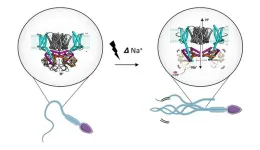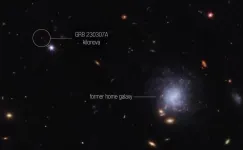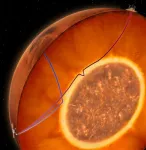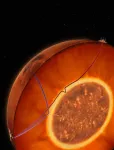Sperm's secret voltage switch: Scientists unlock the mystery of motility
2023-10-25
(Press-News.org)
Researchers at Stockholm University have unveiled the hidden intricacies of how sperm go from passive bystanders to dynamic swimmers. This transformation is a pivotal step in the journey to fertilization, and it hinges on the activation of a unique ion transporter.
Imagine sperm as tiny adventurers on a quest to reach the ultimate treasure, the egg. They don't have a map, but they make use of something even more extraordinary: chemo-attractants. These are chemical signals released by the egg that act as siren call, directing and activating the sperm. When these signals bind to receptors on the sperm's surface, it triggers a series of events, starting their movement towards the egg. And in this intricate scenario, one key player is a protein known as "SLC9C1."
It's exclusively found in sperm cells, and it is usually not active. However, when the chemo-attractants interact with the sperm’s surface, everything changes.
“SLC9C1 operates like a highly sophisticated exchange system. It swaps protons from inside the cell for sodium ions from the outside, temporarily creating a less acidic environment within the sperm. This change in the internal environment triggers increased sperm motility“, says David Drew, Professor in Biochemistry at Stockholm University.
The activation of SLC9C1 is driven by a change in voltage that occurs when chemo-attractants attach to the sperm. To accomplish this, SLC9C1 uses a unique feature called a voltage-sensing domain (VSD). Typically, VSD domains are associated with voltage-gated ion channels. But in the case of SLC9C1, it's something truly exceptional in the realm of transporters.
Researchers, led by David Drew, have unveiled the secrets behind SLC9C1's inner workings and provides the first example of voltage-sensing domain activation of a transporter and its connection via an unusually long voltage-sensing (S4) helix.
“The VSD domain responds to the change in voltage by pushing its rodlike S4 helix inwards. This clears the way for ion exchange by SLC9C1, ultimately initiating sperm motility”, says David Drew.
“Transporters work very differently than channels and, as such, the VSD is coupled to the sperm protein in a way that we have just never seen before, or even imagined. Its exciting to see how nature has done this and perhaps, in the future, we can learn from this to make synthetic proteins that can be turned-on by voltage or develop novel male contraceptives that work by blocking this protein”, David Drew notes.
The research was made possible through funding from the European Research Council (ERC) grant EXCHANGE.
Contact info: David Drew, Professor in Biochemistry, Stockholm University
Email: david.drew@dbb.su.se
Phone: +46 72-14 627 44
END
[Attachments] See images for this press release:


ELSE PRESS RELEASES FROM THIS DATE:
2023-10-25
Researchers have developed a new way of improving diagnosis of bipolar disorder that uses a simple blood test to identify biomarkers associated with the condition.
The researchers, from the University of Cambridge, used a combination of an online psychiatric assessment and a blood test to diagnose patients with bipolar disorder, many of whom had been misdiagnosed with major depressive disorder.
The researchers say the blood test on its own could diagnose up to 30% of patients with bipolar disorder, but that it is even more effective when combined with a digital mental health assessment.
Incorporating biomarker ...
2023-10-25
Illegal hunting and trading of wildlife in China is becoming a significant threat to biodiversity and public health, according to a new paper by a team of researchers that includes two scholars from the School of Public and International Affairs. It is the first comprehensive assessment of this issue for China.
The paper, "Assessing the illegal hunting of native wildlife in China," appears in Nature today. Its co-authors are Dan Liang, Xingli Giam, Sifan Hu, Liang Ma, and David S. Wilcove. Liang is an associate research scholar at SPIA's Center for Policy Research on Energy and the ...
2023-10-25
About The Study: In this study with 9,479 participants, racial and ethnic survival disparities were identified in patients with early-stage breast cancer receiving standardized initial care, and potentially at-risk subgroups, for whom focused interventions may improve outcomes, were found.
Authors: Erica T. Warner, Sc.D., of Massachusetts General Hospital in Boston, is the corresponding author.
To access the embargoed study: Visit our For The Media website at this link https://media.jamanetwork.com/
(doi:10.1001/jamanetworkopen.2023.39584
Editor’s Note: Please see the article for additional ...
2023-10-25
About The Study: Terminating metformin treatment was associated with increased dementia incidence in this study of 12,000 early terminators and 29,000 routine users of metformin. This finding may have important implications for clinical treatment of adults with diabetes and provides additional evidence that metformin is associated with reduced dementia risk.
Authors: Sarah F. Ackley, Ph.D., of Boston University, Boston, is the corresponding author.
To access the embargoed study: Visit our For The Media website at this link https://media.jamanetwork.com/
(doi:10.1001/jamanetworkopen.2023.39723)
Editor’s Note: Please see the article ...
2023-10-25
Researchers at the National Institute of Standards and Technology (NIST) and their colleagues have built a superconducting camera containing 400,000 pixels — 400 times more than any other device of its type.
Superconducting cameras allow scientists to capture very weak light signals, whether from distant objects in space or parts of the human brain. Having more pixels could open up many new applications in science and biomedical research.
The NIST camera is made up of grids of ultrathin electrical wires, cooled to near absolute zero, in which current moves with no resistance until a wire is struck by a photon. In these superconducting-nanowire cameras, the energy imparted by ...
2023-10-25
A study led by UCLA researchers found that the children of parents who experienced adverse childhood experiences (ACEs)– such as abuse, neglect, violence in the home, or loss of a parent – are at increased risk of arrests and convictions by young adulthood. The authors report that their findings suggest that there is a crucial need for prevention of ACE exposure in the first place, as well as efforts to mitigate the impact of ACEs before they have downstream impacts on the next generation of children who are not yet born. The study appears in JAMA ...
2023-10-25
Scientists have observed the creation of rare chemical elements in the second-brightest gamma-ray burst ever seen – casting new light on how heavy elements are made.
Researchers examined the exceptionally bright gamma-ray burst GRB 230307A, which was caused by a neutron star merger. The explosion was observed using an array of ground and space-based telescopes, including NASA’s James Webb Space Telescope, Fermi Gamma-ray Space Telescope, and Neil Gehrels Swift Observatory.
Publishing their findings today in Nature (25 Oct), ...
2023-10-25
The first data from the InSight mission made it possible to determine the internal structure of Mars in a series of papers from the scientific team published in the summer of 2021. However, since then, the analysis of new data generated by a powerful meteorite impact that occurred on September 18 2021, questioned the first estimates of the internal structure of the Red Planet. By studying the propagation times of waves generated by this impact, an international team led by Henri Samuel, CNRS researcher at the Institut ...
2023-10-25
NASA’s InSight mission to Mars helped scientists map out Mars’ internal structure, including the size and composition of its core, and provided general hints about its tumultuous formation.
But findings from a new paper published in the journal Nature could lead to reanalysis of that data. An international team of researchers discovered the presence of a molten silicate layer overlying Mars’ metallic core—providing new insights into how Mars formed, evolved and became the barren planet it is today.
Published on October 25, 2023, the team’s paper details the use of seismic data to locate and identify a thin layer of molten ...
2023-10-25
Scientists have long debated the Anthropocene Epoch, a proposed unit of geologic time corresponding to the most recent period in history. It’s characterized by substantial human impact on the planet.
Are we living in the Anthropocene? And if we are, then when did it start?
In a research article published this month in The Proceedings of the National Academy of Sciences, The University of Toledo’s Dr. Trisha Spanbauer and Stanford University’s Dr. M. Allison Stegner lend credence to the argument for its existence. The pair analyzed open-source data to track vegetation ...
LAST 30 PRESS RELEASES:
[Press-News.org] Sperm's secret voltage switch: Scientists unlock the mystery of motility






